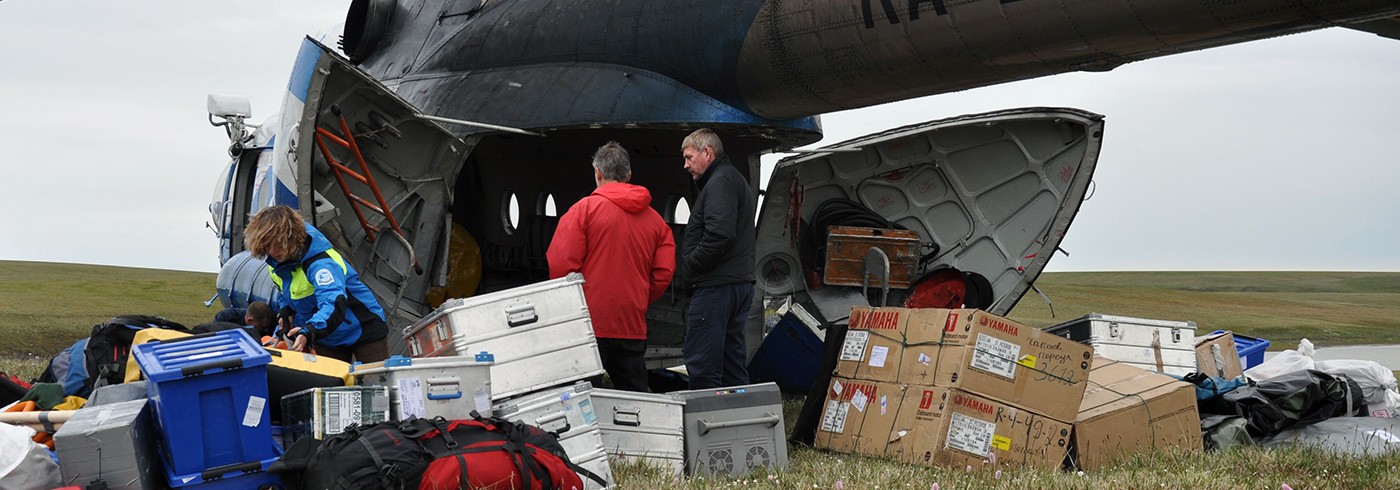The waves never stopped rolling in, so we had to stay put during Monday, the planned departure day back to Khatanga. Constant strong wind from the northwest during 4 days, and with no tendency to stop. So alternatives had to be planned; was there any possibility to get out a Mi8 on Wednesday? Last escape possibility; a passenger boat was said to come Novorybnoe in the afternoon on Wednesday, arriving back late in the evening in Khatanga…

Swimming reindeers
However, on Tuesday after lunch there was a sudden change; within an hour the wind went down and the breaking waves died out. We quickly packed down the camp into boats and were off up-streams the Khatanga River in the early afternoon. It became a nice trip on partly mirror-calm waters in the nicest weather. At several occasions we had to steer around reindeers swimming across the river. We arrived to Khatanga after some 5 hours with the sun just dropping down below the horizon for an hour or so, and then had to wait for the zodiac with most equipment that should be transported to our warehouse. It became quite late in the night before we could throw our self into the beds at “Khatanga Hilton”.

Kenneth in a Zodiac
Wednesday, the work with repacking all our own equipment and sorting out and packing samples in appropriate boxes went smooth; we were finished in the afternoon and ready for take off. We said goodbye to our valuable logistic personnel from INTAARI, Sergey Kessel and Sergey Sacharov, who were to stay another one and a half week to sort out all camping equipment, partly selling what could be swallowed by the Khatanga market, and sending the rest of it together with all samples as cargo to St Petersburg.

Our plane left Khatanga on Thursday morning, and after a 5 hours flight with a propeller plane we were in Krasnoyarsk, approximately 2 000 km south of Khatanga, a large (~90 000 inhabitants) and beautifully located city at the river bank of the Yenisei River. By pure chance we got into one of the best restaurants in Krasnoyarsk. Here we got a wonderful expedition-end dinner with salted mouksun (fish), tender venison chops with mushroom sauce, and cheesecake for desert, all at a very reasonable price – this is not touristic St Petersburg!

Dinner in St. Petersburg
Friday took us to St Petersburg after a 4.5 hours flight; with the time difference (4 hours) it was only lunch time when we arrived. We said goodbye to Polina and Andrei – St Petersburg is their home town – and then went touristic. We thus had a nice afternoon strolling along the St Petersburg canals and visiting some of its most beautiful churches, the St Isaac’s Cathedral and the most marvellous “Church of the Savior on Spilled Blood”. This church was built on the spot where Emperor Alexander II was assassinated in March 1881 and it hosts some fantastic mosaics on bible themes and also the most beautiful intarsia floors of different types of marble. The evening was ended with a very Russian dinner and then some street night life at a café along Nevsky Prospect. Quite another world than Khatanga!

Saint Isaac’s Cathedral in St. Petersburg.

Church of Savior on Spilled Blood in St. Petersburg.
Flight to Kastrup via Arlanda on Saturday, and afters saying goodbye to Kenneth, I, Johanna and Martin were back in Lund in the evening. I am now sitting here in the “mediterranean patio” part of my garden on a warm glorious Sunday morning (25°C), precisely as I wrote in the final remarks on the blog from 2010, “surrounded by vines, my olive, lemon and orange trees, and the clay pots filled with thriving lemon verbena, pineapple sage and basil”. Since then it has been added figs and a lime tree. It is then time for a short summary of the 2012 Taymyr expedition.
We travelled the Luktakh, Upper Taymyr and Logata Rivers for ~350 km, setting out eight base camps. In addition to this we made an additional ~300 km reconnaissance trips or “work trips” to found sites a bit outside our base camps. We have documented 15 geological sites around these base camps, including taking samples for OSL (34), ESR (27) and radiocarbon (20) dating. In addition to this come Kenneth’s three main sites in ice complex sediments with in total ~120 samples for DNA analysis, combined with radiocarbon dating on sediments and sampled mega-fauna remains. The Novorybnoe site, investigated in the final expedition week, was not as spectacular as I had hoped. But sampled units will hopefully give a much more accurate chronology when OSL and ESR results are at hand.
Even though the geologic sites along our travelled rivers were not so spectacular as along the Bolshaya Balakhnya in 2010, it will all together give us a much greater understanding of processes and timing of glaciations and deglaciations on the Taymyr Peninsula over the two last glacial cycles, and hopefully the goal for my research project will be fulfilled. But it will take a few years until the final papers are published!
Per Möller, Lunds universitet

